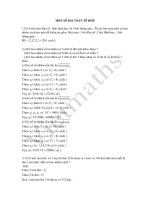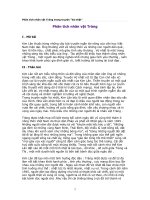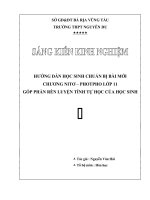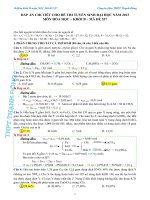- Trang chủ >>
- Đề thi >>
- Đề thi lớp 11
Đề thi Olympic hóa học Nga vòng 1 2017
Bạn đang xem bản rút gọn của tài liệu. Xem và tải ngay bản đầy đủ của tài liệu tại đây (234.51 KB, 10 trang )
51th International Mendeleev Olympiad, 2017
1st theoretical tour
Astana
Problems
Problem 1
“I’ll be back”
Terminator T-800
Paying tribute to my constant co-author
Plastic pollution is defined as accumulation of plastic products in the environment producing
a negative impact on animal and human habitats. This problem is among the most vital challenges
facing humanity nowadays. Surprisingly, sometimes nature itself offers assistance, such as
bioremediation. Thus, Japanese researchers have recently discovered that the bacterium Ideonella
sakaiensis can use polyethylene terephthalate (PET), a polymer with an extremely high resistance
towards biodegradation, as the major source of carbon and energy.
O
O
O
O
n
PET biodegradation involves two enzymatic steps catalyzed by hydrolases and leading to
three low molecular weight (М<600 g/mole) aromatic products A, B, and C with the number of
types of hydrogens of 2, 4, and 6, respectively. After penetration inside Ideonella sakaiensis cells, C
is metabolized into А, which turns out to be the only source of carbon for the bacterium.
1.
Show the chemical bonds (use arrows) in the PET formula that are cleaved in the process of
its hydrolase-catalyzed biodegradation.
2.
Draw all possible structures of A, B, and C, which are in agreement with the given data.
A undergoes a three-step enzyme catalyzed metabolic transformation (all chemical equations):
O2
A
A1
NADPH + H+
NADP+
O
O2
CO2
A2
NADP+ NADPH + H+
X
A3
OH
X
X is a functional group in A3, NADP+ and NADPH are oxidized and reduced co-enzyme
forms, respectively.
3.
Deduce the structural formula of A3 if its molar fractions of oxygen and hydrogen are equal
and lower than that of carbon.
4.
Draw the structural formulae of A1 and A2.
5.
Choose the correct statement concerning Ideonella sakaiensis in the Answer Sheet.
It was reported that the rate of the PET-based film biodegradation by an established bacterial
colony with a constant number of cells is of 0.13 mg∙cm–2∙days–1.
6.
Calculate how many days the colony would need to degrade 1 mass% of spherical PET
granules with the diameter of 1 cm and density of 1.45 g∙cm–3.
The possibility of PET hydrolysis was previously shown for cutinase, the enzyme involved in
nature in a similar process of degradation of the biopolymer cutin, which is the major component of
-1-
51th International Mendeleev Olympiad, 2017
1st theoretical tour
Astana
Problems
cuticle covering plant leaves. The compound D (70.54% С, 11.84% H, and 17.62% O by mass) is
the major monomer in cutin biosynthesis.
7.
Deduce the structure of D (М < 300 g/mole) if it is an unbranched compound free of chiral
carbon atoms.
8.
Draw the monomer unit of the polymer composed solely of D.
Problem 2
Proteins are composed of a-amino acid residues linked together by peptide bonds between
carboxylic and amino groups. Alongside such canonical (proteinogenic) a-amino acids, there are
other natural compounds containing amino and acidic groups. Being involved in metabolic
processes, the latter substances are not found in proteins. Thus, the compound A with the molar
mass of 125 g/mole is used as a drug and nutritional supplement. It reveals much more pronounced
acidic properties than those of a-amino acids.
1.
Give one example of each of optically inactive and optically active canonical a-amino acids.
Draw the latter as a Fischer projection of the isomer incorporated into proteins during biosynthesis.
Indicate the absolute configuration (R/S) of the asymmetric center.
A is a white crystalline powder readily soluble in water and poorly in most organic solvents.
Values of the acidity constants pKa of the acidic and ammonium groups in A equals 1.50 and 8.74,
respectively, whereas there are no other ionogenic groups in A.
2.
Write down expressions for the acidity constants. Denote the neutral form of A as HA, and
the acidity constants as K1 = Ka(H2A+) and K2 = Ka(HA).
3.
Show the prevailing form of an amino acid at its isoelectric point (the total charge of all the
amino acid forms equals zero) using alanine (2-aminopropionic acid) as an example.
4.
Calculate the pH value of the А solution at its isoelectric point.
5.
What is the molar fraction of the completely uncharged form of A in the above solution if
ionization of the ionogenic groups in A occurs independently?
The antimicrobial compound Х was first synthesized from A according to the hereunder scheme:
O
O
A
6.
Cl
NaOH (excess)
B
1) PCl5
2) NH3
C
H2
Pd/C
1) H+
D
Draw the structural formulae of A – D.
-2-
2) HCHO/NaHCO3
N
O S
N
O H
N
X
N
H
S O
O
51th International Mendeleev Olympiad, 2017
1st theoretical tour
Astana
Problems
А is very important for mammals. Most of them are capable of biosynthesizing it form an aamino acid E in three consecutive enzymatic steps (enzymes Е1 – Е3) given hereunder. The process
includes only decarboxylation and two-electron oxidation reactions. Still, A is an indispensible
substance for some mammals because of low decarbolylase activity, which terminates the synthesis
at the second step and makes the presence of A in the diet obligatory.
E
7.
E1
E2
F
E3
G
A
Write down the three-step scheme of the А biosynthesis showing the structures of the
intermediates and starting amino acid E.
А was first time isolated as its sodium salt from bovine bile. А interacts with bile acids
(cholic, in particular) providing conjugates, which act as surfactants facilitating emulsification of fats
in intestinal track. In liver, cholic acid combines with glycine and A affording H and I, respectively.
O
OH
OH
H
H
H
HO
8.
H
H
OH
cholic acid
Draw the structural formulae of H and I. Which of these is a more potent emulsifier of fats?
Choose the molecule and encircle the functional group responsible for the enhanced emulsifying
ability.
-3-
51th International Mendeleev Olympiad, 2017
1st theoretical tour
Astana
Problems
Problem 3
Alkene oxidation reactions belong to the most widespread methods of C–C double bond
functionalization in the organic synthesis.
O
KMnO4, H2O
0°C
Ia
1.
R
H
O O
NaOH / H2O
A
Ib
Write down structural formulae of compound A and stereoisomers Ia and Ib if both Ia and А
has a plane of symmetry but compound Ib has not.
Stereoselectivity of epoxidation of cyclohexenes bearing a substituent at the allylic position
depends on the nature of this substituent.
O
R
B
2.
H
O O
O
OH
CH3COCl
Py
R
C
H
O O
D
Write down structural formulae of compounds B – D if epoxidation is determined by either
steric factor (for one transformation) of intermolecular hydrogen bond formation wherein
substituent in the cyclohexene moiety is a hydrogen bond donor (for another one).
CO2Et
Sharpless developed an enantioselective epoxidation of allylic alcohols
based on the use of t-BuOOH as an oxidant and Me(OR)n as a catalyst. Here,
EtO2C
Me is a transition metal and OR is a chiral ligand. Namely, this ligand is
H
OH
H
either (+)- or (–)-diethyl tartrate ((+)-DET and (-)-DET, respectively). The
OH
stereochemical formula of (–)-DET is given below as a Newman projection.
3.
Write down structural formula of (–)-DET using the Fischer projection. Belong this molecule
to D- or L-hydroxyacids?
Racemic mixture of (+)- and (–)-DET is synthesized from but-2-enedioic acid (II) by reaction
with RCO3H followed by treatment of product with aq. NaOH.
4.
Write down structural formula of compound II.
5.
Determine the formula of alcoholate Me(OR)n if spectrum 1Н NMR contains two signals
(doublet and septet with the relative intensity of 6:1), and wC = 50.7%.
To determine a major enantiomer of oxirane, formed in the above
reaction, the Sharpless rule is applied. According to this rule, molecule of
allyl alcohol derivative is presented by way given below. If (–)-DET is using
for epoxidation, epoxide ring is formed above the alkene plane. If (+)-DET is
(-)-DET
R
R'
CH2OH
R''
(+)-DET
using, a new ring is formed below this plane.
The oxidation of (Z)-tridec-2-en-1-ol (E) using t-BuOOH/Me(OR)n/(-)-DET system into
compound F is the key step in one of the synthesis of disparlure (pheromone of gypsy moth
Lymantria dispar).
-4-
51th International Mendeleev Olympiad, 2017
1st theoretical tour
6.
Astana
Problems
Write down structural formulae of compounds E and F. Point out the absolute configuration
(R/S) for the chiral centers in molecule of F.
Problem 4
Oxidation of iodide ion with hydrogen peroxide in acidic medium occurs slowly. When we
add a compound instantly binding molecular iodine, the iodine color does not appear for a certain
time (lag period). When 0.125 M H2O2 and 0.05 M KI (concentrations are given in the reaction
mixture at the start of the reaction) and ascorbic acid (AA, see Fig.; its concentrations at the start of
the reaction were 1.25∙10–4, 5∙10–4 and 1.25∙10–3 М) were mixed at pH 4.5, the iodine color
appeared after t = 4, 16 and 40 s, respectively.
HO H
HO
HO
O
O
OH
1.
Write down:
a)
Slow reaction (1) of oxidation of iodide ion with hydrogen peroxide in acidic medium;
b)
Fast reaction (2) that retards the appearance of molecular iodine color (denote
dehydroascorbic acid as C6H6O6);
c)
Equation relating the time of appearance of color t with the concentration of ascorbic acid in
solution (calculate the numerical value of the coefficient of proportionality);
d)
Kinetic equation of the rate of consumption of H2O2 according to reaction (1) at a constant
pH, taking into account that it has the first order in iodide ion (denote the rate constant as k1).
2.
Given that the rates of consumption of AA and reaction (1) are equal, calculate:
a)
The rate of consumption of AA by reaction (2) in mol/(L·s);
b)
The value of the rate constant k1 of reaction (1), taking the current concentrations of the
components equal to the original ones;
c)
The duration of the lag period t for 0.05 M H2O2, 0.05 M KI and 1.25∙10–3 M AA at pH 4.5,
assuming current concentrations of the components are equal to their initial concentrations.
3.
Molybdate ion catalyzes the oxidation of iodide with peroxide, since supramolybdic acid
H2MoO5 and its anions oxidize iodide faster than H2O2 does.
a)
Assuming that molybdate is present only in the form of H2MoO5, write down the kinetic
equation for this reaction in its general form (denote the rate constant as kMo).
b)
Estimate the value of the constant kMo in presence of 1∙10–4 M MoO42–, if the lag period was
50 s for the conditions specified in point 2c.
c)
Calculate the duration of the lag period for 3∙10–4 M molybdate.
-5-
51th International Mendeleev Olympiad, 2017
1st theoretical tour
Astana
Problems
Problem 5
Ladderanes form very interesting class of hydrocarbons, unusual structural fragment of which
is present in the Nature in lipids of planctomycetes that realize anammox, i.e. ANaerobic
AMMonium OXidation. The molecular formula of [2]-ladderane, the simplest representative of this
class, is С6Н10. This compound can be produced in low yield by photolysis of norbornan-2-one or
1,5-hexadiene.
O
1.
hu
hu
[2]-ladderane
Hg, gas phase
Hg, gas phase
(C6H10)
5%
4%
Write down structural formula of [2]-ladderane if it is known that: a) it has no free rotating
bonds; b) its 1Н NMR spectrum consists of 3 signals, c) two signals are present in its
13
С NMR
spectrum. Write name of [2]-ladderane using IUPAC nomenclature.
Molecular formula of [3]-ladderane is С8H12; it has two stereoisomers: anti-[3]-ladderane,
having one plane of symmetry, and syn-[3]-ladderane, having two planes of symmetry. Both
isomers were synthesized from cis-3,4-dichlorocyclobut-1-ene. Its treatment with sodium amalgam
produces very active intermediate А (С4Н4) which dimerizes immediately affording compound В.
The catalytic hydrogenation of В yields syn-[3]-ladderane. On the another hand, treatment of cis3,4-dichlorocyclobut-1-ene with lithium amalgam gives rise to organolithium compound С
(LiC8H8Cl) which spontaneously eliminate lithium chloride with formation of hydrocarbon D, the
catalytic hydrogenation of which accomplishes synthesis of anti-[3]-ladderane.
B
syn-[3]-ladderane
(C8H12)
2.
[A]
C4H4
Na/Hg
Cl
Et2O
Li/Hg
Et2O
[C]
LiC8H8Cl
Cl
-LiCl
D
anti-[3]-ladderane
(C8H12)
Decipher structures of [3]-ladderanes. Write down structural formulae of compounds В, D as
well as reactive intermediates А and С.
3.
Write down the general structural formula of [n]-ladderanes no accounting for
stereochemistry of these compounds.
Anaerobic bacteria Candidatus Brocadia anammoxidans use the transformation of NO2- and
NH4+ into N2 and H2O as the source of energy. This process proceeds in organelle that has very
unusual membrane: 90% of lipid component of this membrane is formed by pentacycloanammoxic
acid, C20H30O2. The key structural element of this acid is [5]-ladderane which has only antiarrangement of rings. It is also known that this acid has 9 tertiary carbon atoms, has no quaternary
carbons; carbon atom of the ladderane scaffold, bearing a substituent, has (S)-configuration.
4.
Write down structural formula of pentacycloanammoxic acid.
-6-
51th International Mendeleev Olympiad, 2017
1st theoretical tour
Astana
Problems
Problem 6
It was a serious breakthrough in chemistry with the discovery of
electricity: the birth of electrochemistry, the discovery of new elements, etc.
In 1807 Humphry Davy obtained the metals A and B by electrolysis of their
molten compounds. The reactivity of these elements is incomparable, thus,
being on the air, they quickly turn into a mixture of oxides, peroxides,
nitrides, carbonates and others.
H. Davy (1778 – 1829)
During the combustion of B on the air the orange substance C (ω (O) = 45%) is formed, the
combustion of A causes the formation of other oxygen-compound H (ω (O) = 41%) of pale yellow
colour. Both C and H compounds are used for the regeneration of oxygen in submarines and
spacecraft. This process is based on the interaction between C and carbon dioxide, which leads to
the formation of D and oxygen. Evaporating of the solution obtained by reacting of D with
hydrochloric acid, the compound E may be prepared, which is the starting material for obtaining B
by the reaction with A in industry. The latter reaction of obtaining B is used even more in industry
than electrolysis. This process takes place in a stainless steel column: the melt of E moves
downwards and the vapour of A moves down up. The vapour of B sublimes and condenses in the
refrigerator. Upon cooling the solution obtained by adding C to the acidified by sulfuric acid
solution of aluminum sulfate is obtained well-faceted colorless crystals F. At the reaction of the
solution of F with sodium perchlorate, a white precipitate G is obtained, which is one of the few
poorly soluble metal compounds of B.
1.
Determine the A – H formulae, write the equations according to the scheme:
A
O2
t°
E
2.
HCl
H
O2
B
D
C
CO2
Al2(SO4)3
H2SO4
F
NaClO4
G
What is the reason of the equilibrium shift towards producing products in the reaction of
obtaining metal B from the melt of E and the vapour of A? Specify true in the answer sheet.
Typically, A and B in all the compounds exhibit a positive oxidation state, however, there are
examples of complex compounds in which these metals are present in a negative oxidation state.
3.
Among the above ligands in the answer sheet, select those in the complex compounds of
which A has a negative oxidation state.
It is known that A and B form an intermetallic compound. The mole fraction of B is 33.3%.
4.
Identify the composition of intermetallic compound.
-7-
51th International Mendeleev Olympiad, 2017
1st theoretical tour
Astana
Problems
Problem 7
There are many types of cement, but the most widespread one is Portland cement. It is mostly
(more than 90%) composed of ground clinker, whose approximate composition is given in the table
below. The properties of Portland cement are commonly defined by two calcium silicates, X and Y,
in the clinker. The mass fractions of calcium in X and Y are 52.66% and 46.54% respectively. The
first row of the table below contains the international designations (in cement chemistry) of various
components of the clinker. In reality, clinker comprises approximately 2–3% mass. of minor
components (oxides of potassium, sodium, phosphorus, manganese, sulfur, hydrogen, etc. in bound
states, which come from the source materials), but we will not consider them in this problem.
Designation
Composition
ω,%
X
62.0
Y
16.0
C4AF
Ca4Al2Fe2O10
8.50
C3A
Ca3Al2O6
12.0
M
MgO
1.50
The raw materials used in making the clinker are various natural minerals: limestone (calcite),
clay (kaolinite Al2O3×2SiO2×2H2O), periclase (MgO), iron ore (Fe2O3) and quartz sand. All the
aforementioned minerals contain SiO2 as an impurity, which is 8.50% of the minerals by mass. In
addition to SiO2, iron ore also contains 4.10% of Al2O3, and clay contains 4.60% of Fe2O3. All the
starting materials are mixed together in required proportions and calcined (heated when exposed to
air) at 1500 °С in special rotating furnaces to obtain clinker. After cooling and grinding, the clinker
is mixed with gypsum (under these conditions, it partially dehydrates to form gypsum plaster, also
known as plaster of Paris) to produce Portland cement. The amount of gypsum added must be so
that the mass fraction of sulfur oxide (VI) in the final product is 3.00%.
Because the compositions of natural raw materials used in the process are not constant in a
real industrial process, the ratios of the components used in making clinker must constantly be
adjusted. The properties of Portland cement are most affected by the ratio of X and Y, which
depends on the ratio of SiO2, Al2O3 and Fe2O3 in the clinker. In order to control this ratio, the Lime
Saturation Factor (LSF) is used, which is computed by using the mass fractions of the
aforementioned oxides in the clinker. The Lime Saturation Factor is computed as follows:
ω(CaO)
2.80 × ω(SiO 2 ) + 1.18 × ω(Al2O3 ) + 0.650 × ω(Fe 2 O3 )
The LSF characterizes the ratio between quantities of X and Y, as well as the degree of
LSF =
binding of CaO in the clinker. If LSF = 1, then only X is present and there is no Y, and if LSF>1,
then X and unbound CaO are present. The magnitude of LSF is used to confirm that the
composition of cement is standardized, and will behave in a predictable manner.
1.
Determine the chemical formulas of X and Y and give their international designations.
2.
Calculate the masses of all components needed to produce 100 tons of Portland cement.
3.
Calculate the mass fractions of all oxides in Portland cement.
-8-
51th International Mendeleev Olympiad, 2017
1st theoretical tour
4.
Astana
Problems
Calculate LSF for Portland cement of the above composition. Show your calculations.
In all calculations, use atomic masses rounded to the nearest integer. The final answers should
have at least three significant figures.
Problem 8
Hydrogen is a promising renewable energy
source. One of the ways of production of hydrogen is
photocatalytic decomposition of water. The mechanism
of the process is presented in figure. Titanium dioxide
can serve as an example of such a photo-catalyst.
Under light excitation with photon energy, greater than
the band gap of the semiconductor (Eg) electrons transfer
to the conduction band, leaving holes (h+) in the valence band. The efficiency of the process
decreases because of rapid recombination of the pairs e--h+. For charge separation the catalyst is
doped by transition metals.
1.
Choose the metals in the table, addition of which can improve the efficiency of photo-
catalytic decomposition of water.
Ion
Fe3+
Mn2+
Co2+
Ce3+
E0(Men+/Me), V
-0.037
-1.19
-0.28
-2.34
Ion
Pt2+
Ru2+
Cu2+
Ag+
E0(Men+/Me), V
1.12
0.445
0.521
0.7996
In the systems, having particles smaller than 100 nm, size effects are often observed –
dependence of physical-chemical properties of substances from the size of the particles.
Dependence of the band gap on the size of nanoparticles for an oxide semiconductor is expressed by
the formula
E g ( R) = E g 0 +
a b
R2 R ,
where Eg0 – band gap of the bulk phase, μ = me*∙mh*/(me* + mh*) – reduced mass of the effective
masses of electron (me*) and a hole (mh*), ε0 – electric constant, ε – dielectric permittivity, е –
electron charge, R – radius of the particle, a = h2/8m, b = 1.8e2/4pεε0.
2.
а) Calculate the band gap energy value for TiO2 nanoparticles with R = 2 nm, if Eg0 = 3.0 eV,
ε = 184, μ = 0.74 me; b) In what direction shifts the wavelength of radiation which initiates
-9-
51th International Mendeleev Olympiad, 2017
1st theoretical tour
Astana
Problems
conductivity, in case of nanoparticles, compared with bulk phase? с) Calculate the effective mass of
electrons and holes if me* = 12.5 mh*.
Efficiency of photocatalytic hydrogen production can be estimated with the quantum yield φ
- ratio of the number of the "effective" electrons (ne) to the number of photons (np) generated by a
light source per time unit.
3.
Calculate the quantum yield ne/np (%). The maximum rate of hydrogen formation for this
catalyst Vmax = 5.6 μmol/min, light source power P = 67 mW, light wavelength 421 nm.
Kinetics of the reactions, occurring on the photocatalyst surface, can be described using
Langmuir – Hinshelwood model:
K
k
A
A + Z ¬¾
¾
® AZ ¾¾®
P+Z
where Z – adsorption centers, А – organic substrate, Р –
7.0
6.5
reaction rate constant. The rate of hydrogen in this reaction
6.0
K A C0 A
is defined as W(H2 ) = knA, where nA =
1 + K A C0 A
degree of surface coverage. After linearization of the
curve W(H2) the equation y = 3.27 + 1.78x was obtained
(see figure).
4.
Y, h/mmol
product of the reaction, KА – adsorption constant, k -
5.5
5.0
4.5
4.0
0.2 0.4 0.6 0.8 1.0 1.2 1.4 1.6 1.8 2.0 2.2
X, l/mmol
a) Determine, to what variables correspond x and y on the graph; b) calculate k and KА.
Physical constants: h = 6.63×10-34 J×s, NA = 6.02×1023 mol-1, c = 3×108 m×s-1, 1 eV = 1.6∙10-19 J,
me = 9.1×10-31 kg, ε0 = 8.85×10-12 F/m, е = 1.6×10-19 C.
- 10 -









